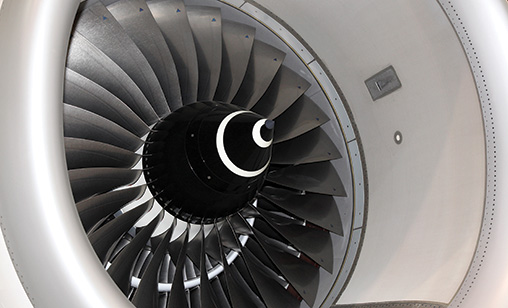Industry Insight Special Report
No place to hide from impact of Big Data
Big Data applications are transforming aviation. Chief correspondent, Tom Ballantyne, outlines its importance in creating pathways to bigger profits at the region’ airlines.
June 1st 2017
Big Data and its impact on aviation has gripped the industry. At every major conference, from airline and airport operations to MRO, customer service and marketing, safety and security, it is central to industry discussions. Read More »
It’s mind boggling ability to scope out information that is critical to selling more airplane seats, delivering more accurate MRO and making giant leaps forward in airliner production is losing jobs in the industry and making flying more efficient and cheaper for airlines, manufacturers and passengers.
 |
In Dubai last month, Chinese global information and communications technology giant, Huawei held a summit, Leading New ICT, The Road to Digital Aviation, to explore innovative ICT solutions for aviation.
Leading ICT technologies are bringing digital collaboration, cloud computing platforms and Big Data analytics to the aviation industry. Digitalization can dramatically optimize passengers’ travel experience, increase airports’ operational efficiency and ensure public safety and operational security at airports,” said the president of the Transportation Sector in Huawei’s Enterprise Business Group, Xilin Yuan.
“Huawei is cooperating with its partners to provide innovative, differentiated, and advanced ICT hardware and software infrastructure for aviation customers, which will enable them to embrace the benefits of digital technologies, remain competitive and thrive in the digital era.”
By the end of 2016, Huawei had provided ICT products, solutions and services for more than 40 airports, airlines, and air traffic control authorities worldwide. Customers included more than 15 airports with more than 30 million passengers annually, including the 10 busiest airports in China by passenger traffic.
At the Aero-Engines Americas Conference in San Antonio, Texas, earlier this year one speaker said the B787 and the A350 are even more connected than the passengers they carry. According to Airbus, even its A380 superjumbo, which first flew a decade ago, collects information on more than 200,000 aspects of every flight.
In a paper published in April, DLA Piper, a global law firm with offices in more than 40 countries including the Asia-Pacific, said an effective digital strategy is critical for the long-term success of any airline.
“The role of digital technology has changed from a source of marginal efficiency gains to the foundation for transformation. Increasingly, airlines recognize the need to innovate to stay ahead of legacy competitors and to pre-empt the disruption of established business models by ambitious and nimble digital natives – the low-cost carriers,” DLA Piper said.
 |
However, as the volume and variety of data increases, so too do the challenges associated with the use of Big Data. For many organizations, navigating the complex landscape of data protection, privacy and cyber security laws will be critical to unlocking the full power of Big Data, advanced analytics and machine learning,” the global law firm forecast.
In a recent interview, vice president and general manager of Thales Avionics Worldwide Services for Americas, Ken Coleman, said aircraft connectivity “is a critical first step but it is what we do with this that will really be transformative for both the front- and back-ends of the airline.
“For example, adding to critical safety services, improving operational performance, providing a seamless ground/air experience for passengers and increasing revenue for airlines.
Predictive maintenance, which uses Big Data to deliver parts to airline customers when they need them, is an industry game changer. Before Big Data entered the sector, MRO managers were left to beg, borrow or steal to ensure the right parts were available at the right time.
The goal was always to keep planes in the air and not in the repair cycle. Without a predictive understanding of when parts were needed, the goal was not always achievable. Companies seeking a competitive advantage tap suppliers who use Big Data to give them an edge over rivals.
Rolls-Royce, the world’s second-biggest aero engine manufacturer, was one of the first OEMs in the industry to use data generated by its engines for innovation. The UK-headquartered company offered its customers an MRO package based on the number of hours its engines kept an aircraft flying. It is now a standard industry practice.
“Today, the average life cycle of an airplane engine is up to 50 years,” said vice president sales in the Americas for MTU Maintenance, Christoph Heck. Lufthansa Technik (LHT) is blending digital analytics with its engineering expertise to make MRO work more predictive for its clients. All of the engine-makers, from Pratt & Whitney to General Electric and CFM are improving their offerings to carriers by employing Big Data information.
Boeing and Microsoft signed an agreement last year to build a cloud-based platform for the U.S. plane maker’s portfolio of commercial aviation analytics tools. They are working towards transferring many of Boeing’s commercial aviation applications to the Microsoft Azure cloud.
“Boeing’s expertise and extensive aviation data resources coupled with Microsoft’s cloud technology will accelerate innovation in areas such as predictive maintenance and flight optimization, allowing airlines to drive down costs and improve operational efficiency,” said Boeing vice president Digital Aviation Kevin Crowley.
 |
Airbus has established a corporate venture capital fund, Airbus Group Ventures, and A3, a technology and business innovation centre in Silicon Valley, aimed to define the future of flight.
IT leaders such Amadeus, Honeywell, Sabre, SITA and Thales are heavily involved in constant research and development of systems to better utilize Big Data information.
DLA Piper said the major challenge for the aviation sector was achievement of a “true” digital transformation of back-end systems, internal processes and end-to-end customer interaction models.
“This means much more than creating a ‘digital wrapper’ for their existing business models. Many aviation businesses are very large, complicated organizations that support hundreds of different business processes in multiple regions and countries. To adapt to the digital world, many are seeking to consolidate and simplify these processes across their entire business, centralize their technology landscape and update their platforms in order to make efficiency gains and better support strategic aims, such as the transformation of the customer experience.”
Industry experts said passenger demand expansion is driven an expanding middle class in emerging markets, lifestyle expectations of millennials and cheaper airfares. To capture these market opportunities, digital technology must be applied.
“The rise of ‘the digital consumer’ is prominent in the aviation sector, where a significantly greater proportion of customers have an online presence compared with other industries,” DLA Piper pointed out.
“With the use of digital technology projected to rise dramatically, with estimates ranging from 13 billion to 50 billion connected devices by 2020, companies are engaging with customers by online purchasing journeys, social listening, feedback apps and links with other players in the aviation, travel and tourism industries.
Airlines are customer apps to check in online and acquire virtual boarding passes, but to announce real time flight delays and boarding times. Luggage tracking to help people make tight transit connections will soon be widespread.
Now onboard WiFi is becoming a reality, some airlines are considering cabins with sensors built in to seats to monitor passengers’ tiredness, temperature or hydration levels that will automatically adapt the airline environment or prompt crew to take a particular action.
So, the bottom line is: the application of Big Data is a critical element for the success of any airline from the cabin to the MRO hangar and from the airport gate to safe landing at the destination of every airliner.